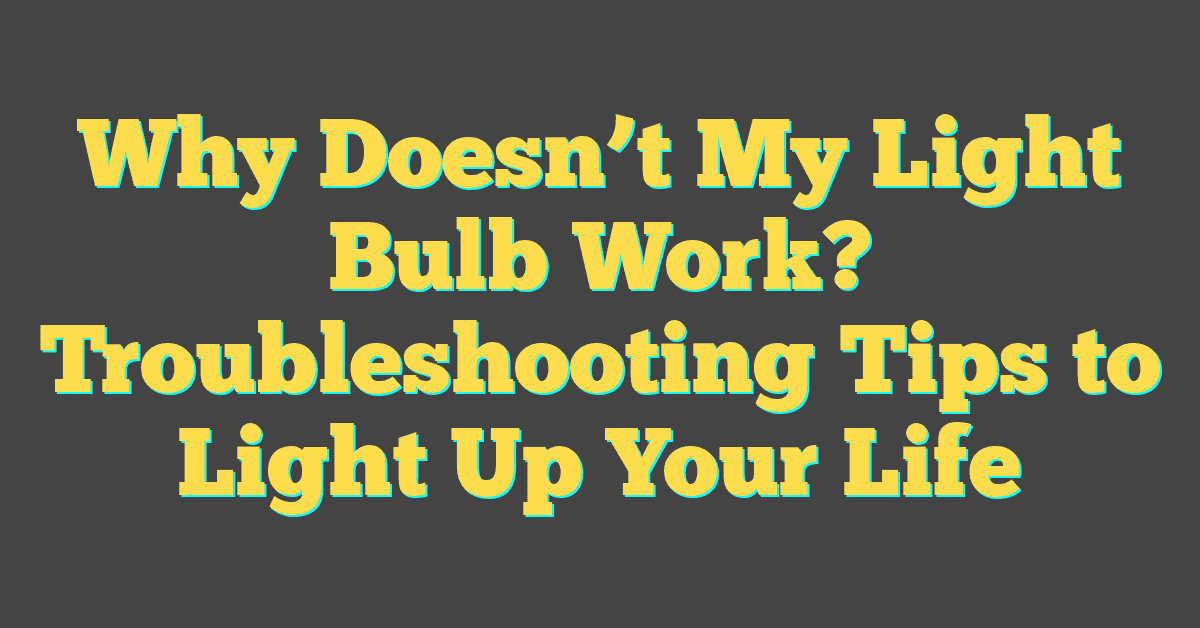Ever found yourself in the dark, flipping the switch back and forth, wondering why your light bulb won’t play ball? It’s a common frustration and you’re definitely not alone in this illuminating predicament.

Before you call it quits and sit in the dim, let’s shed some light on the possible culprits. From pesky burnt-out bulbs to more elusive electrical gremlins, there’s a spectrum of reasons that could be keeping you in the shadows.
So grab your detective hat and a screwdriver—it’s time to uncover why that light bulb isn’t working and how you might fix it without calling in the pros.
Checking the Power Source
When your light bulb fails to illuminate, one of the first things to consider is the power source. Electrical issues can be elusive and sometimes the culprit is as uncomplicated as the switch being off. That’s right, it’s easy to overlook, so double-check that you’ve flipped the switch on. If it’s a lamp, ensure it’s plugged in and the outlet is functioning.
Testing an outlet can be done with a voltage tester or by simply plugging in another device that you know works. If the alternative device doesn’t power up, you’ve found an issue with your outlet. However, if the device works and the bulb still does not, it’s time to investigate further.
Occasionally, a tripped circuit breaker can interrupt power to an entire section of your home. Check your breaker box; if you find a tripped breaker, flipping it back may solve your problem. In houses with fuse boxes, look for a blown fuse—it’ll typically show signs of scorching or discoloration.
If these steps reveal nothing, the issue may lie in the light fixture itself. Flickering lights or ones that go on and off can indicate a loose connection within the fixture. You can tighten the bulb and check for any visible damage or wiring issues. Remember, safety first—always turn off the power from the main switch before poking around in fixtures.
Lastly, it’s worth considering voltage fluctuations. Bulbs demand a particular voltage range to function properly. Too low or too high can affect performance and lifespan. Power spikes or inconsistent electricity flow can damage bulbs over time. You may not notice immediate effects, but it’s something to keep in mind.
Fault finding in the realm of electrical issues can be straightforward or incredibly nuanced. What’s important is methodically working through possibilities, starting with the simplest solutions. Once you’ve ascertained the power source is not to blame, you can delve deeper into the complexities of the bulb’s inner workings.
Inspecting the Light Bulb

When you’ve ruled out external power issues, it’s time to get a closer look at the bulb itself. Grab your trusty ladder or step stool and ensure the light switch is in the off position. Safety first – you don’t want any accidental zaps!
Remove the bulb with care and examine it for visible signs of damage. Look for dark spots or any obvious breaks in the filament. If your bulb is a CFL or LED, check for discoloration or a telltale smell of burning electronics which can indicate it’s time for a replacement.
Don’t forget, bulbs have their own specifications; mixing them up could be why you’re stuck in the dark. Confirm you’re using the correct wattage for your fixture. Using a 100W bulb in a 60W socket can overload the system, not to mention it’s a potential fire hazard.
Next, consider the lifespan of the bulb. While you expect incandescents to last about 1,000 hours, modern LEDs can shine for over 25,000 hours. Here’s a quick breakdown of average lifespans:
| Bulb Type | Average Lifespan (hours) |
|---|---|
| Incandescent | 1,000 |
| Halogen | 2,000 |
| CFL | 10,000 |
| LED | 25,000+ |
If the bulb’s time is up, treat yourself to an upgrade. Maybe even consider stepping into the energy-efficient world of LEDs if you haven’t yet. They’re a game-changer, providing bright, cost-effective lighting with a fraction of the energy expenditure.
« What Kind of Light Bulbs Go in a Ceiling Fan: Brightness, Wattage & Type Revealed
What Kind of Light Bulbs Help Plants Grow? Unlock the Secrets of LED Growth Power »
Lastly, it’s possible the issue could be related to the bulb’s compatibility with your dimmer switch, if you have one. Not all energy-efficient bulbs play nice with older dimmers. If you’ve recently switched bulb types and things aren’t working, your dimmer may need an update.
To sum it up, keep your bulbs fresh, matched to their fixtures, and suited to your dimmer’s technology to ensure a well-lit space that’s easy on the eyes and the electric bill. Remember, the best approach is methodical—eliminate possibilities one by one and you’ll find the solution that lights up your world.
Checking the Wiring

After you’ve ensured the bulb isn’t the issue and you’ve checked for compatibility problems, it’s time to delve a bit deeper. The culprit might just be hiding behind your walls—faulty or loose wiring could be to blame. Here’s how you can proceed, but remember, dealing with electrical wiring demands caution. If you’re not confident, it’s best to call in a professional.
Start with the switch. Sometimes, it’s as simple as a loose wire on the switch itself. Turn off the power at your circuit breaker before removing the switch cover. You’re looking for wires that have come loose from the screw terminals. If you spot any, tighten the screws to secure them. It’s also possible that wires connected to push-in connectors have become loose—these can be reinserted or moved to the screw terminals for a better connection.
Next, take a peek at the light fixture. If there’s a problem in the socket, this could also prevent the bulb from working. Ensure the power is still off and examine where the fixture’s wires connect to your home’s wiring. Look for loose wire nuts or disconnected wires here as well. Tightening loose connections and ensuring wires are properly capped with wire nuts could resolve your light dilemma.
While you’re at it, take the opportunity to inspect the wiring for any signs of wear or damage. Frayed or scorched wires are a telltale sign of electrical issues. If you come across this, don’t attempt to fix it yourself unless you’re well-versed in electrical work. Safety first—you don’t want to turn your DIY project into a call to 911.
In homes with older wiring, the issue might be outdated materials like aluminum wiring or knob-and-tube setups. These can pose serious safety risks and are definitely a job for a seasoned electrician.
Just keep in mind that electrical work can be dangerous and is often best left to professionals, especially if you’re out of your depth. However, if you’re experienced with home DIY and feel confident, tackling the wiring can be a fulfilling challenge. Just remember, safety gear is non-negotiable and always double-check that the power is off before you start fiddling with wires.
Addressing Faulty Switches

When you’re troubleshooting a light bulb that won’t turn on, don’t overlook the possibility of a faulty switch. It might surprise you, but that little toggle or push button you use every day can fail, leaving you in the dark—literally.
Start by listening carefully. A healthy switch should make a definitive clicking sound. If you’re hearing silence or a faint sound, something’s off. First, ensure the power is turned off at the circuit breaker to safely inspect the switch. Remove the switch plate and take a look inside.
Pay attention to how secure the wires are attached to the switch. Even if everything seems fine, switches can wear out internally and may not make the necessary connections. If you’re comfortable with it, you can use a multimeter to test the switch for continuity. If the switch isn’t conducting electricity as it should, it’s time for a replacement.
- Listen for a clicking sound when the switch is toggled.
- Turn power off at circuit breaker before inspection.
- Inspect wire connections for security.
- Use a multimeter to test for continuity.
Replacing the switch is often a straightforward task if you have some DIY experience. You’ll need a new switch, a screwdriver, and maybe some wire nuts. Ensure the switch you select matches the type needed for your light fixture, particularly if you’re working with dimmers or three-way switches.
Remember safety first! If you’re not well-versed in electrical DIY, or if the wiring doesn’t look straightforward, don’t hesitate to call a professional. Improperly installed electrical components can pose serious risks. When it comes to electricity, it’s better to be safe than sorry.
Switch issues are common culprits in lighting problems. By methodically checking from bulb to wiring, and now to switches, you’re that much closer to pinpointing the issue. Keep your multimeter handy, and continue to consider each potential problem area with the diligence of a detective on a case.
Troubleshooting Other Electrical Issues

While examining the switch and the bulb can often yield a solution, sometimes the issue lies a bit deeper in the electrical system. Circuit breakers are a safety mechanism to prevent overloads, and if your light isn’t working, a tripped breaker could be the culprit.
To check the breaker:
- Locate your electrical panel, normally found in basements or garages.
- Look for breakers that are in the “off” position or stuck in the middle.
- Reset any tripped breakers by flipping them to “off” and then back to “on.”
If this is a recurring issue, there could be an underlying problem like circuit overload or a faulty breaker. In such cases, it might be wise to seek help from a qualified electrician.
Another potential issue could be a burnt-out or loose outlet where the lamp is plugged in. Here’s what to do:
- Unplug the lamp and test the outlet with another working device.
- If the device doesn’t work, the issue might be with the outlet.
- Inspect the outlet for any signs of damage or burn marks.
For the more tech-savvy, a multimeter can come in handy to check for voltage and ensure the outlet is functioning correctly. Remember, safety first—don’t perform tests you’re not comfortable with and always turn off the power before doing any electrical work.
Lastly, consider the possibility of a worn out or damaged lamp cord:
- Check the cord along its length for any signs of fraying or cuts.
- Gently shake the cord to see if the light flickers, indicating a loose connection.
- If damage is evident, the lamp will either need repair or replacement.
From your favorite home DIY enthusiast to another, learning to troubleshoot and fix these common electrical issues not only saves you money but also provides a certain satisfaction. However, when you’re stumped, don’t hesitate to reach out to a pro—it’s all about striking that perfect balance between DIY and expert intervention.
Conclusion
Alright, you’ve gone through a comprehensive checklist to get to the bottom of your light bulb woes. Remember, it’s all about taking it step by step—from checking the bulb itself to investigating the wiring, switch, and other electrical components. If you’ve tried it all and that bulb still won’t light up, don’t hesitate to call in a pro. It’s better to be safe than sorry when dealing with electricity. Here’s to brightening up your space without any further hiccups!
Frequently Asked Questions
What should I check if my light bulb isn’t working?
Inspect the bulb for visible damage and verify that it’s the correct wattage. Also, consider the bulb’s lifespan and whether it’s time to upgrade to an energy-efficient LED.
Can a dimmer switch cause a light bulb to not work?
Yes, compatibility issues between the light bulb and the dimmer switch may prevent the bulb from working. Check if your bulb type is compatible with your dimmer switch.
What wiring issues could cause a light bulb to stop working?
Loose wires at the switch or within the light fixture can cause this issue. Examine for loose wire nuts or disconnected wires, but exercise caution, as electrical work can be dangerous.
Is it possible for a faulty switch to be the problem?
Absolutely, a faulty switch could prevent a light bulb from turning on. Troubleshoot by listening for a clicking sound, checking wire connections, and using a multimeter to test for continuity.
What should I do if my electrical expertise is limited?
If you’re unsure about electrical work, prioritize safety and consider calling a professional to avoid any risks associated with troubleshooting electrical issues.
How do I address issues with circuit breakers or outlets?
For circuit breakers, look for and reset any tripped ones. For outlets, check for burn-out or looseness. If you find damaged lamp cords, replace them, but seek professional help if you’re not comfortable doing these tasks.




